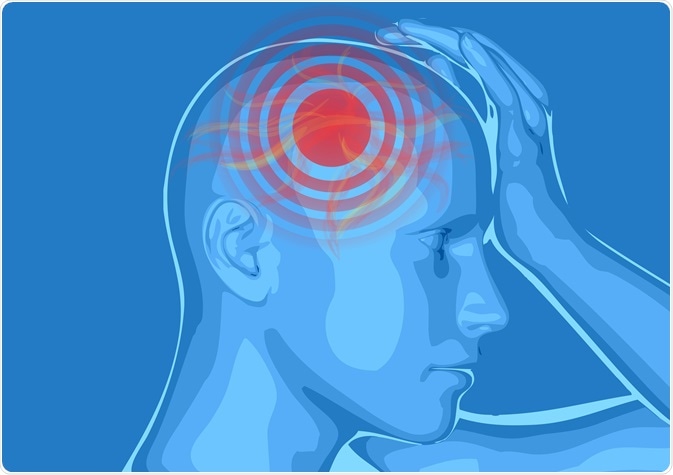Headaches can occur due to a variety of reasons, with most of them not being serious. Whilst there are well over 200 types of headache, there are typically two major types of headaches: primary (90%), in which the headache is a ‘headache-condition’ in itself (for example, migraine or tension headache), and secondary (10%), in which the headache results from another condition (for example, stroke).
 Image Credit: Arkela / Shutterstock.com
Image Credit: Arkela / Shutterstock.com
The intensity or type of pain can be related to the severity of the cause (e.g., mild to moderate) or associated factors, such as level of dehydration. The location of a headache may also be important in identifying the cause of certain types of headaches, but not in all.
Bilateral vs. unilateral
At the highest level of headache localization, the headache can either be bilateral (both sides) or unilateral (one side). Typically a migraine presents unilaterally (one side of the head) and has a pulsating quality. Migraines may also present with other symptoms such as nausea (vomiting) and photosensitivity (sensitivity to light).
Tension-type headaches, on the other hand, present bilaterally (both sides of the head) and have a pressing or tightening quality. There is no throbbing or pulsating quality to these headaches and few other physical symptoms. Often with these headaches, the localization is poor and may appear more general over areas of the head and neck.
Sinus headaches (sinusitis) occur around or behind the orbital area (eyes), across the cheeks and along the forehead, and in some cases along the top teeth. These often present with a pressing quality and are typically constant. These headaches typically co-occur with nasal and auditory congestion, a fever, and the swelling of the face.
Trigeminal Autonomic Cephalalgia
Less common types of headaches that are less generalized and more localized may be attributed to trigeminal autonomic cephalagias (TACs). These occur with the simultaneous activation of the trigeminal system and the autonomic nervous system to produce short-term, unilateral headaches with ipsilateral (same side of the body) symptoms including lacrimation (crying) and rhinorrhoea (runny nose).
Specific TACs present at different locations on the head and can, therefore, be diagnosed on the basis of location. For example, cluster headaches, which are severe stabbing headaches occurring in the orbital/temporal areas (around the eyes and towards the ears).
Short-lasting unilateral neuralgiform headache attacks (SUNA), which are severe burning and stabbing sensations, occur in the periorbital area only (around the eyes). A third type, hemicrania continua, present as moderate pressing pain in the nuchal to frontal areas of the head (nape of the neck to the front part of the skull).
Another type of headache, occipital neuralgia, which is not a TAC, presents as piercing, throbbing, electrical-shock like chronic pain in the upper neck, and the back of the head behind the ears on one side. Sometimes the pain is also present behind the eyes.
This syndrome is related to the areas where the occipital nerve runs from the base of the brainstem up to the scalp and the back of the head. Patients also present with photosensitivity and a tender scalp. Occipital neuralgia is, therefore, often confused with migraine due to the unilateral pain and overlapping symptoms.
Summary
In most cases, the location of a headache is non-specific and not important in identifying the type of headache. Knowing whether the headache is unilateral or bilateral can help differentiate between certain types of headaches, such as migraine or tension headache.
However, specific syndromes, such as TAC and sinus headaches, present with highly localized pain, whose characteristics can be used to differentiate between the conditions. Most headaches come on gradually and persist for some level of time, then disappear. However, if the headache is very sudden and presents with extreme pain (thunderclap), then you need to seek medical emergency immediately, as this could be a sign of a brain aneurysm or stroke (see Differences between an Aneurysm and Migraine).
Sources
Rizzoli & Mullally, 2018. Headache. Am J Med. 2018 131(1):17-24. https://www.ncbi.nlm.nih.gov/pubmed/28939471
A May, 2018. Hints on Diagnosing and Treating Headache. Dtsch Arztebl Int. 115(17): 299–308. https://www.ncbi.nlm.nih.gov/pmc/articles/PMC5974268/
Further Reading
Last Updated: Dec 13, 2019